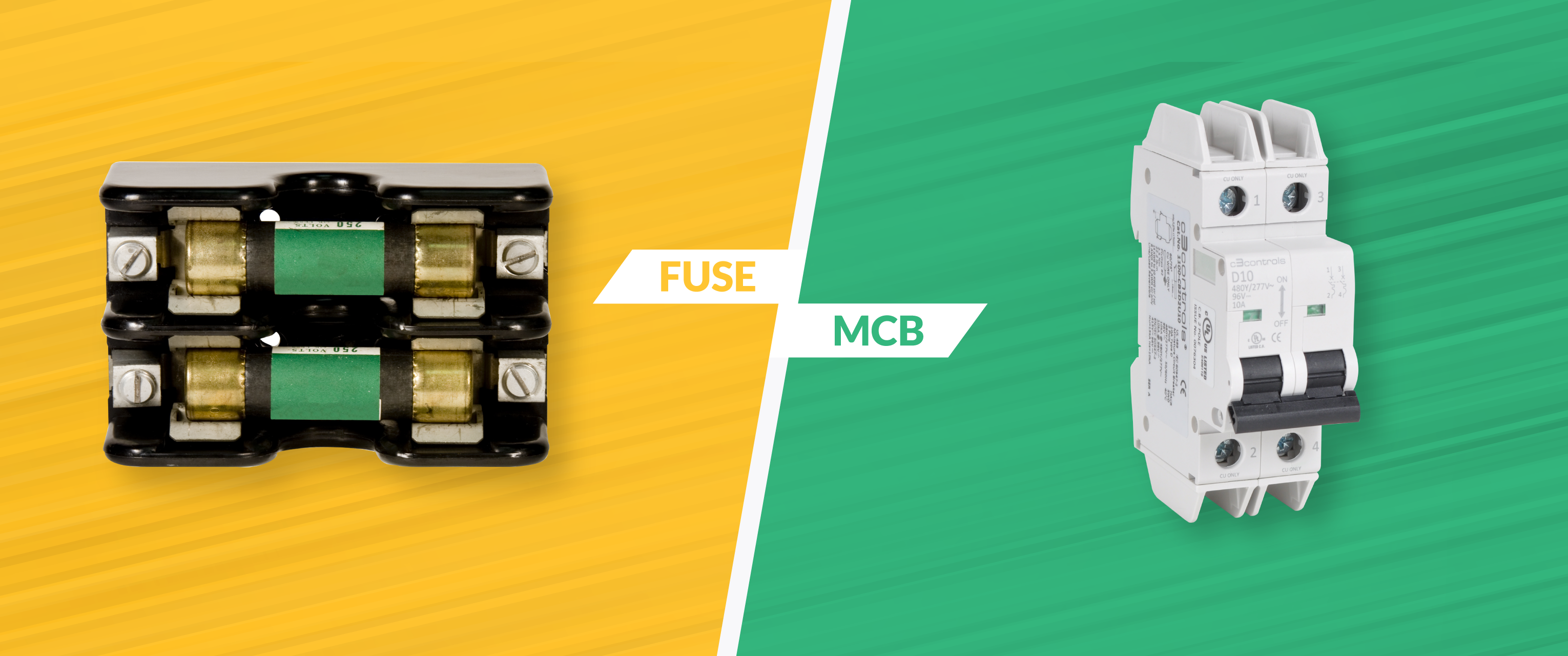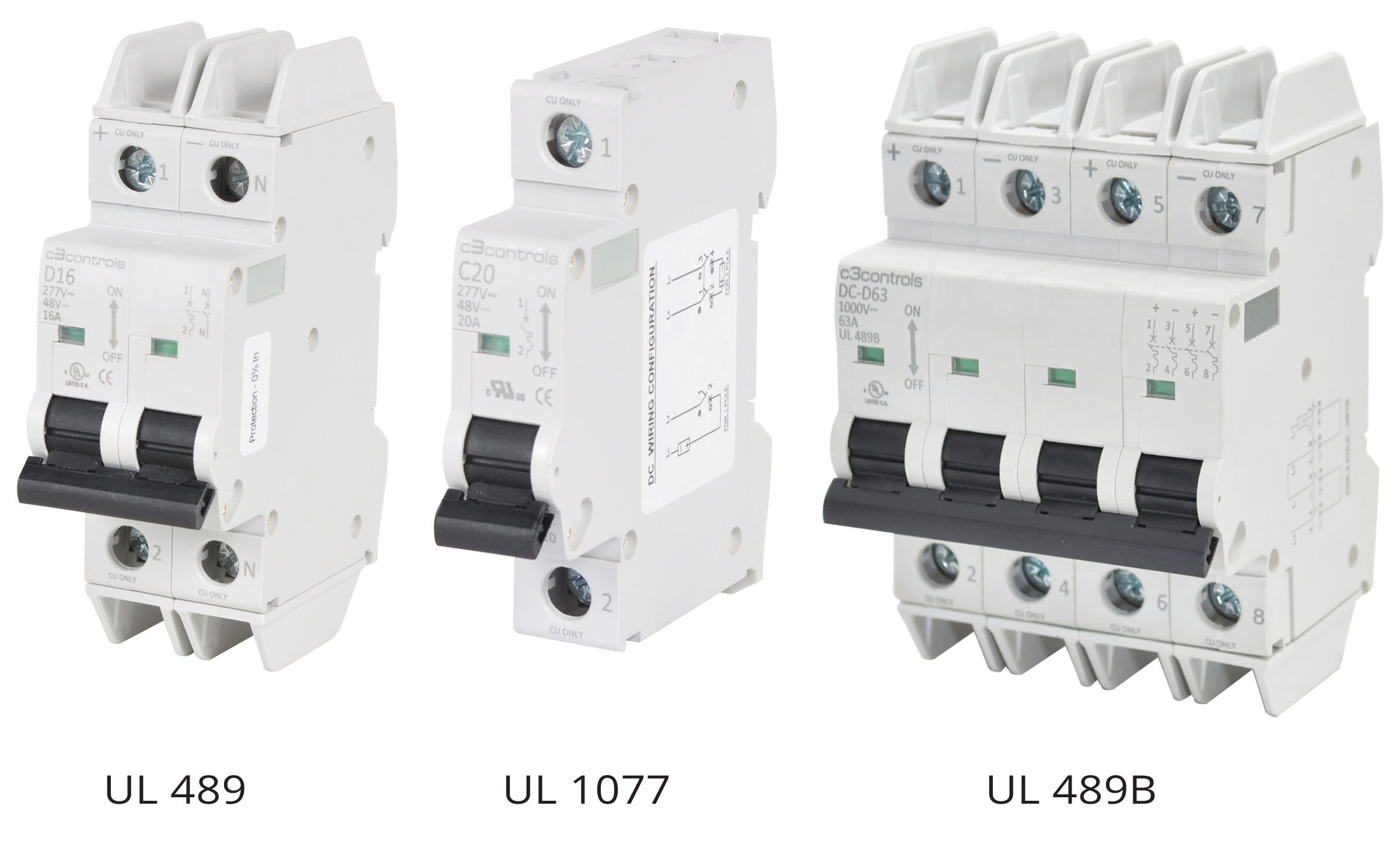Note: This paper provides only an introduction to the subject. Any system changes should be planned and executed by qualified professionals.

Overview
Fuses and miniature circuit breakers (MCBs) have several common features and functions. They both serve as protective devices, primarily designed to safeguard electrical circuits and connected equipment from overcurrent conditions, which can result from overloads, short circuits, or electrical faults. Fuses and MCBs are both suitable as standard electrical panel components and each possess specific current ratings to match their protection to the circuit’s current-carrying capacity. Despite their commonalities, fuses and MCBs work in different ways:
- Fuses: Fuses are common, non-resettable protective devices consisting of a metal wire or element that melts when subjected to excessive current. When the current in a circuit exceeds the fuse’s rating, the wire melts, breaking the circuit and stopping the flow of electricity. Fuses are sacrificial components and must be replaced after they operate, as they cannot be reset. Fuses are a simple way to provide basic protection against overcurrents in electrical systems.
- MCBs: MCBs are more advanced protective devices. When excessive current, such as an overload or short circuit, is detected, an MCB automatically trips, interrupting the flow of electricity in the circuit. MCBs are resettable, which means they can be easily turned back on after a trip, providing convenient, cost-effective, and precise protection as trip settings can be selected to match the specific requirements of the circuit. MCBs can also have additional safety features, such as ground fault protection and arc fault protection in some models, enhancing electrical safety and overall control in electrical systems.
Modern MCBs have become the preferred choice and continue to replace fuses in residential, commercial, and industrial applications due to their reliability, ease of use, and superior control over electrical protection. However, fuses are still utilized in some instances despite their shortcomings compared to MCBs. The common hesitancy to switch from fuses to MCBs revolves around the primary driver behind many of the decisions we make — cost. Let’s address that concern.
Upfront Cost
While fuses tend to have a higher operating cost (which we will address later), that is not always enough for buyers who are only interested in costs that are visible upfront. These individuals remain fixated on the initial cost with the assumption that fuses are cheaper. But, are fuses actually cheaper than circuit breakers?
To compare the upfront cost of fuses and breakers, let’s shop from reputable sources for a UL 489 MCB and a UL class CC fuse (both 30A). For an MCB, you can shop directly from the manufacturer at c3controls.com. Your web price will be approximately $23 per pole for a UL 489 MCB:
- UL 489 MCB (Single Pole): $23.21
- UL 489 MCB (Two Pole): $46.42
- UL 489 MCB (Three Pole): $69.63
Now, let’s shop for a UL class CC, time-delay fuse. For this product we’ll go to grainger.com. Grainger is a top distributor of industrial and safety supplies, offering fuses from leading manufacturers. Your web price will fall in an approximate range of $18 - $35 per class CC fuse:
- UL Class CC, Time-Delay Fuse (Single): $17.70 - $34.79
- UL Class CC, Time-Delay Fuse (Two): $35.40 - $69.58
- UL Class CC, Time-Delay Fuse (Three): $53.10 - $104.37
Let’s visualize that data to see where a UL 489 MCB falls in the price range of a UL class CC fuse:

Based on this data, it would seem that there are more affordable class CC fuses than UL 489 breakers, right? Not so fast. Remember, for safe and reliable operation fuses must be used in conjunction with fuse holders:
- Fuse Holder: A fuse holder, or fuse block, is a critical electrical component that securely connects and positions a fuse within an electrical circuit. Its importance lies in its functions: it securely mounts the fuse, establishes a reliable connection, enhances safety by shielding components, and simplifies fuse replacement. Fuse holders are essential for proper fuse installation, safety, and efficient maintenance.
Knowing that a fuse holder is required, let’s now shop for a class CC, open, screw fuse holder. We’ll again go to the trusted grainger.com. The web price depending on the number of poles will be the following:
- UL Class CC, Screw Fuse Block (Single Pole): $15.19
- UL Class CC, Screw Fuse Block (Two Pole): $23.93
- UL Class CC, Screw Fuse Block (Three Pole): $32.47
The cost of the fuse block must be added to the upfront cost to more accurately visualize the data:

Here we can see that the upfront cost of the class CC fuses are NOT actually cheaper than that of the UL 489 breakers for single, two, or three pole configurations. Think of how substantial the difference could become for larger applications that use dozens, hundreds, or thousands of these units…
Operating Cost
Now, let’s examine the post-purchase operating cost of fuses vs MCBs. When an MCB trips, the “repair” is as simple as flipping a switch. When a fuse is blown, the entire fuse needs to be replaced. Here’s an example of the costs that could be incurred replacing fuses over a 20-year timeframe.
Example: You have a fuse box with 12 fuses. Luckily, each fuse is only going to blow twice over the 20-year sample size for a total of 24 replacements. For each blown fuse, your system must be shut off and it will take 2 hours to identify the problem, replace the fuse, and test the circuit for a total of 48 hours of maintenance. You can expect to pay a qualified electrician the average rate of $100 per hour for this service.
Operating Cost =
- Cost of downtime: (48 hours * $100/hr = $4,800) +
- Cost of 24 replacement fuses* +
- Cost of any replacement fuse holders* +
- Loss of business during system shutdown +
- Other
In our conservative example you would lose a minimum of $4,800, with many more added costs, by not using MCBs over fuses. Again, think of how high that number would grow for larger applications and businesses!
Conclusion
The purpose of this paper was to disprove the common misconception that fuses are cheaper than breakers. Of course there are many different types of fuses and breakers, but it is shown that MCBs can offer both lower upfront and lifetime operating costs while delivering improved safety, precision, and convenience. These benefits can be an advantage to businesses and industries, allowing them to allocate their resources more efficiently and invest in other critical areas of their operations.
Want to conduct the Fuse vs. MCB comparison specifically for your application? Contact us and get in touch with a sales professional.
Thinking of switching to breakers? Shop UL 489, UL 489B, UL1077 MCBs and more at c3controls.com!

----------------------------------------
Descargo de responsabilidad:
El contenido proporcionado en este documento técnico está destinado únicamente a fines de brindar información general y se proporciona en el entendimiento de que los autores y editores no se dedican a la prestación de servicios de ingeniería, consultoría u otros servicios profesionales. La práctica de la ingeniería está impulsada por circunstancias específicas y únicas para cada proyecto. En consecuencia, cualquier uso de esta información debe realizarse solo con previa consulta a un profesional calificado y con licencia que pueda tener en cuenta todos los factores relevantes y los resultados deseados. La información de este documento técnico se publicó con un cuidado y una atención razonables. Sin embargo, es posible que parte de la información contenida en estos documentos técnicos esté incompleta, sea incorrecta o no se aplique a circunstancias o condiciones particulares. No aceptamos responsabilidad por pérdidas directas o indirectas que resulten de usar, confiar o actuar sobre la información en este documento técnico.
ISO 9001:2015
Certificado
Más de 17 millones de productos
Configuraciones
Toda la vida
Garantía
Garantizado
Envíos en el mismo día
Precios ventajosos
Ahorre hasta un 40%
c3controls Headquarters, USA
664 State Avenue
Beaver, PA 15009
